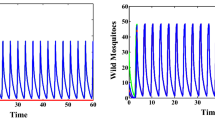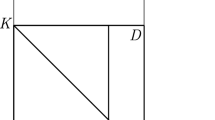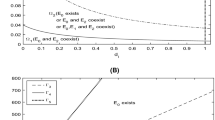Abstract
Releasing Wolbachia-infected male mosquitoes to suppress wild female mosquitoes through cytoplasmic incompatibility has shown great promise in controlling and preventing mosquito-borne diseases. To make the release logistically and economically feasible, we propose a saturated release strategy, which is only implemented during the epidemic season of mosquito-borne diseases. Under this assumption, the model becomes a seasonally switching ordinary differential equation model. The seasonal switch brings rich dynamics, including the existence of a unique periodic solution or exactly two periodic solutions, which are proved by using the qualitative property of the Poincaré map. Sufficient conditions are also obtained for determining the stability of the periodic solutions.






Similar content being viewed by others
References
Ai S, Fox M (2021) Four positive equilibria in a model for sterile and wild mosquito populations. Appl Math Lett 121:107409
Bacaër N (2011) A short history of mathematical population dynamics. Springer, London
Boyer S, Gilles J, Merancienne D, Lemperiere G, Fontenille D (2011) Sexual performance of male mosquito Aedes albopictus. Med Vet Entomol 25:454–459
Cai L, Ai S, Fan G (2018) Dynamics of delayed mosquitoes populations models with two different strategies of releasing sterile mosquitoes. Math Biosci Eng 15:1181–1202
Duan J, Lin L, Cai S, Liu W et al (2009) Study on the stepwise responses for risk categories for dengue fever vector. Chin J Vector Biol Cont 20:51–54
Farkas JZ, Hinow P (2010) Structured and unstructured continuous models for Wolbachia infections. Bull Math Biol 72:2067–2088
He M, Tang S, Tang G, Xiang C (2021) Bifurcation analysis of an ecological system with state-dependent feedback control and periodic forcing. Int J Bifurcat Chaos 31:2150227
He S, Zhang X, Liang J, Tang S (2017) Multiscale modelling the effects of CI genetic evolution in mosquito population on the control of dengue fever. Sci Rep 7:13895
Huang J, Ruan S, Yu P, Zhang Y (2019) Bifurcation analysis of a mosquito population model with a saturated release rate of sterile mosquitoes. SIAM J Appl Dyn Syst 18:939–972
Huang M, Yu J, Hu L, Zheng B (2016) Qualitative analysis for a Wolbachia infection model with diffusion. Sci China Math 59:1249–1266
Khan IU, Tang S, Tang B (2019) The state-dependent impulsive model with action threshold depending on the pest density and its changing rate. Complexity, 6509867
Li J (2008) Differential equations models for interacting wild and transgenic mosquito populations. J Biol Dyn 2:241–258
Li J, Yuan Z (2015) Modelling releases of sterile mosquitoes with different strategies. J Biol Dyn 9:1–14
Li Y, Liu X (2018) A sex-structured model with birth pulse and release strategy for the spread of Wolbachia in mosquito population. J Theor Biol 448:53–65
Li Y, Liu X (2020) Modeling and control of mosquito-borne diseases with Wolbachia and insecticides. Theor Popul Biol 132:82–91
Liu F, Yao C, Lin P, Zhou C (1992) Studies on life table of the natural population of Aedes albopictus. Acta Sci Natl Univ Sunyaatseni 31:84–93
Sazama EJ, Bosch MJ, Shouldis CS et al (2017) Incidence of Wolbachia in aquatic insects. Ecol Evol 7:1165–1169
Su Y, Zheng B, Zou X (2022) Wolbachia dynamics in mosquitoes with incomplete CI and imperfect maternal transmission by a DDE system. Bull Math Biol 84:95
Tang S, Cheke RA (2005) State-dependent impulsive models of integrated pest management (IPM) strategies and their dynamic consequences. J Math Biol 50:257–292
Turelli M (2010) Cytoplasmic incompatibility in populations with overlapping generations. Evolution 64:232–241
Vinogradova EB (2007) Diapause in aquatic insects, with emphasis on mosquitoes. Diapause Aquat Invertebr Theor Human Use, Springer, Netherlands 112:218–224
Wang Y, Liu X, Li C, Su T, Jin J, Guo Y et al (2017) A survey of insecticide resistance in Aedes albopictus (diptera: Culicidae) during a 2014 dengue fever outbreak in Guangzhou, China. J Econ Entomol 110:239–244
Xi Z, Khoo CCH, Dobson SL (2005) Wolbachia establishment and invasion in an Aedes aegypti laboratory population. Science 310:326–328
Xiao J, He J, Deng A et al (2016) Characterizing a large outbreak of dengue fever in Guangdong Province, China. Infect Dis Poverty 5:44
Yan Z, Hu Z, Jiang Y et al (2010) Factors affecting the larval density index of Aedes albopictus in Guangzhou. J Trop Med 10:606–608
Yu J (2018) Modelling mosquito population suppression based on delay differential equations. SIAM J Appl Math 78:3168–3187
Yu J (2020) Existence and stability of a unique and exact two periodic orbits for an interactive wild and sterile mosquito model. J Differ Equ 269:10395–10415
Yu J, Li J (2020) Global asymptotic stability in an interactive wild and sterile mosquito model. J Differ Equ 269(7):6193–6215
Yu J, Li J (2022) A delay suppression model with sterile mosquitoes release period equal to wild larvae maturation period. J Math Biol 84:14
Zhang D, Zheng X, Xi Z, Bourtzis K, Gilles JRL (2015) Combining the sterile insect technique with the incompatible insect technique: I-Impact of Wolbachia infection on the fitness of triple- and double-infected strains of Aedes albopictus. PLoS ONE 10:e0121126
Zhang H, Georgescu P, Zhang L (2016) Periodic patterns and Pareto efficiency of state dependent impulsive controls regulating interactions between wild and transgenic mosquito populations. Commun Nonlin Sci Numer Simul 31:83–107
Zhang Z, Zheng B (2022) Dynamics of a mosquito population suppression model with a saturated Wolbachia release rate. Appl Math Lett 129:107933
Zheng B (2022) Impact of releasing period and magnitude on mosquito population in a sterile release model with delay. J Math Biol 85:18
Zheng B, Li J, Yu J (2022) Existence and stability of periodic solutions in a mosquito population suppression model with time delay. J Differ Equ 315:159–178
Zheng B, Li J, Yu J (2022) One discrete dynamical model on Wolbachia infection frequency in mosquito populations. Sci China Math 65:1749–1764
Zheng B, Yu J, Xi Z, Tang M (2018) The annual abundance of dengue and Zika vector Aedes albopictus and its stubbornness to suppression. Ecol Model 387:38–48
Zheng B, Yu J, Li J (2021) Modeling and analysis of the implementation of the Wolbachia incompatible and sterile insect technique for mosquito population suppression. SIAM J Appl Math 81:718–740
Zheng B, Yu J (2022) Existence and uniqueness of periodic orbits in a discrete model on Wolbachia infection frequency. Adv Nonlinear Anal 11:212–224
Zheng B, Yu J (2022) At most two periodic solutions for a switching mosquito population suppression model. J Dynam Differ Equ. https://doi.org/10.1007/s10884-021-10125-y
Zheng X, Zhang D, Li Y, Yang C, Wu Y, Liang X et al (2019) Incompatible and sterile insect techniques combined eliminate mosquitoes. Nature 572:56–61
Acknowledgements
This work was supported by the National Natural Science Foundation of China (11971127, 12071095).
Author information
Authors and Affiliations
Corresponding author
Ethics declarations
Conflicts of interest
The author declares no conflict of interest.
Additional information
Publisher's Note
Springer Nature remains neutral with regard to jurisdictional claims in published maps and institutional affiliations.
Appendices
Appendices
A Computing the poincaré map
The Poincaré map p(u) is bridged by \({\bar{p}}(u)\), and the relation between \({\bar{p}}(u)\) and p(u) is governed by equation (1.9) when \(t\in [\phi T,T)\). Initiated from \(w(\phi T)\), equation (1.9) can be solved as
Integrating (A.1) from \(\phi T\) to T then yields
It follows from (A.2) that to compute p(u), we only need to specify \({\bar{p}}(u)\), which is governed by equation (1.8) when \(t\in [0,\phi T)\). We write (1.8) as
where
Next, we compute \({\bar{p}}(u)\) in two cases.
1.1 Case 1: \(\varvec{c}_{2}={0}\)
When \(c_2=0\), we get \(b=b^*\), and we rewrite equation (A.3) as
with \(E^*=-c_1>0\). Equation (A.4) can be decomposed to
where
From (A.5) we get
Integrating (A.6) from 0 to \(\phi T\), we have
1.2 Case 2: \(\varvec{c}_{2}\ne {0}\)
In this case, equation (A.3) can be decomposed to
where
Elementary calculation yields
where
with
Hence, integrating (A.8) from 0 to \(\phi T\) offers
B Computing \(\varvec{p}'(0)\) for local stability of \(E_0=0\)
The computation of \(p'(0)\) divides into two separate cases.
1.1 Case 1: \(\varvec{c}_{2}=0\)
Since \({\bar{p}}(0)=0\), from (A.7), we get
Note that
we have two cases to consider when calculating \({\bar{p}}'(0)\).
-
(1)
If \(\lim _{u \rightarrow 0}\left( \frac{1}{{\bar{p}}(u)}-\frac{1}{u}\right) \) is finite, then (B.1) implies that \({\bar{p}}'(0)=1\).
-
(2)
If \(\lim _{u \rightarrow 0}\left( \frac{1}{{\bar{p}}(u)}-\frac{1}{u}\right) =-\infty \), then \({\bar{p}}'(0)=0\). However, revisiting (B.1) again leads to \(\lim _{u \rightarrow 0}\left( \frac{1}{{\bar{p}}(u)}-\frac{1}{u}\right) =+\infty \), a contradiction.
Combining the above two cases, we get \({\bar{p}}'(0)=1\). It follows from (A.2) that
and hence
where
1.2 Case 2: \(\varvec{c}_{2}\ne {0}\)
We obtain, from (A.10)
Equation (A.2) and (B.3) imply
where
It’s easy to see that \(c_2=0\) if and only if \(b=b^*,\) under which
Hence, by defining
we have
Proposition B.1
When \(T>T^*\), one has \(p'(0)>1\) and hence \(E_0\) is unstable. When \(T<T^*\), then \(p'(0)<1\) and \(E_0\) is locally asymptotically stable.
Proof
From (B.2) and (B.4), we get \(p'(0)>1\) if \(T>T^*\), which implies that there exists a small enough \(\delta >0\) such that \(p(u)>u\) for \(u \in \left( 0, \delta \right) .\) Together with the fact that for any \(u \in \left( 0, \delta \right) \), then sequences \(\{w(nT; 0,u)\}\) is strictly increasing, which means that solution w(t; 0, u) does not go to zero as \(t\rightarrow \infty \), hence \(E_0\) is unstable. Similarly, when \(T<T^*\), we have \(p'(0)<1\), then there is \(\delta ^*>0\) sufficiently small such that \(p(u)<u\) for \(u \in \left( 0, \delta ^*\right) .\) We know that the sequences \(\{w(nT; 0, u)\}\) is strictly decreasing and so there are some solutions w(t; 0, u) such that \(\lim _{t \rightarrow \infty }w(t; 0,u)=0\) for \(u \in \left( 0, \delta ^*\right) ,\) hence \(E_0\) is locally asymptotically stable. \(\square \)
C Sufficient conditions for the stability of the T-periodic solution
Lemma C.1
Let \(w(t; 0, {\bar{u}})\) be the unique T-periodic solution lying in \(U^0({\bar{u}}, \gamma )= ({\bar{u}}-\gamma , {\bar{u}}) \cup ({\bar{u}}, {\bar{u}}+\gamma )\) with \(\gamma >0\). If
then \(w(t; 0, {\bar{u}})\) is asymptotically stable.
Proof
First, we claim that \(p(u)<u\) implies
Otherwise, we assume that \(t_{0}\) is the first time point such that \( w\left( t_{0}+T; 0, u\right) =w\left( t_{0}; 0, u\right) \). Write \({\bar{w}}(t)=w(t+T; 0, u)\), or, equivalently, \({\bar{w}}(t)=w(t; 0, w(T))=w(t; 0, p(u))\), which is also a solution of (1.8)-(1.9). Comparing w(t) and \({\bar{w}}(t)\) at \(t_{0}\), we have
which contradicts the existence and uniqueness of initial value problems, proving (C.2). Similarly, we can prove that if \(p(u)>u\), then
if \(p(u)=u\), then w(t; 0, u) is a T-periodic solution.
Now, we show that \(w(t; 0, {\bar{u}})\) is asymptotically stable if (C.1) holds. Without loss of generality, we only consider the case with \(u \in ({\bar{u}}, {\bar{u}}+\gamma )\). For any \(\varepsilon = \gamma >0\), if
then choose \(\delta =\varepsilon \), we have
Otherwise, if
then there must be a \(\gamma _{1}<\gamma \) such that
Choosing \(\delta =\gamma _{1}\), we get
which completes the proof of the stability of \(w(t; 0, {\bar{u}})\).
Regarding the attractivity of \(w(t; 0, {\bar{u}})\), we begin with proving that for given \(t_1\ge 0\),
We assume by contradiction that there exists \({\hat{u}}\ne {\bar{u}}\) such that
which implies that
Hence we get another T-periodic solution, which leads to a contradiction to the uniqueness of the T-periodic solutions in \(u \in U^0({\bar{u}}, \gamma )\). This completes the proof of the Lemma C.1. \(\square \)
Lemma C.2
With \(U^0({\bar{u}}, \gamma )\) defined as in Lemma C.1, if
then \(w(t; 0, {\bar{u}})\) is unstable.
Proof
For any \(\delta \in (0, \gamma )\), it follows from (C.3) that \(p(u)>u\) for \(u\in ({\bar{u}}, {\bar{u}}+\delta ]\), and \(p(u)<u\) for \(u\in [{\bar{u}}-\delta , {\bar{u}}),\) which leads to
Hence
proving the instability of \(w(t; 0, {\bar{u}})\). \(\square \)
Lemma C.3
It follows from Lemmas C.1 and C.2 that if
and
then \(w(t; 0, {\bar{u}})\) is unstable from the left-side. However, \(w(t; 0, {\bar{u}})\) is stable from the right-side.
Rights and permissions
Springer Nature or its licensor (e.g. a society or other partner) holds exclusive rights to this article under a publishing agreement with the author(s) or other rightsholder(s); author self-archiving of the accepted manuscript version of this article is solely governed by the terms of such publishing agreement and applicable law.
About this article
Cite this article
Zhang, Z., Chang, L., Huang, Q. et al. A mosquito population suppression model with a saturated Wolbachia release strategy in seasonal succession. J. Math. Biol. 86, 51 (2023). https://doi.org/10.1007/s00285-023-01888-7
Received:
Revised:
Accepted:
Published:
DOI: https://doi.org/10.1007/s00285-023-01888-7
Keywords
- Wolbachia
- Mosquito population suppression
- Saturated release rate
- Periodic solutions
- Existence and stability




